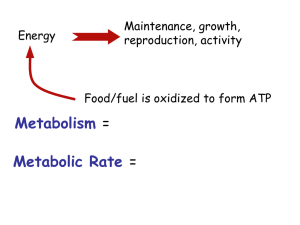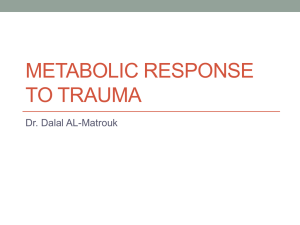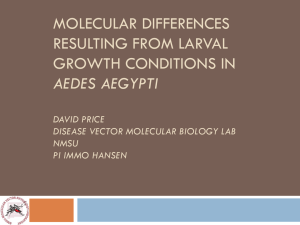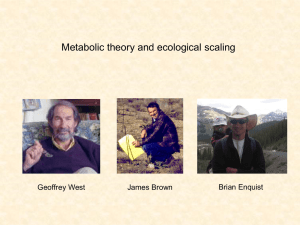Metabolic
advertisement
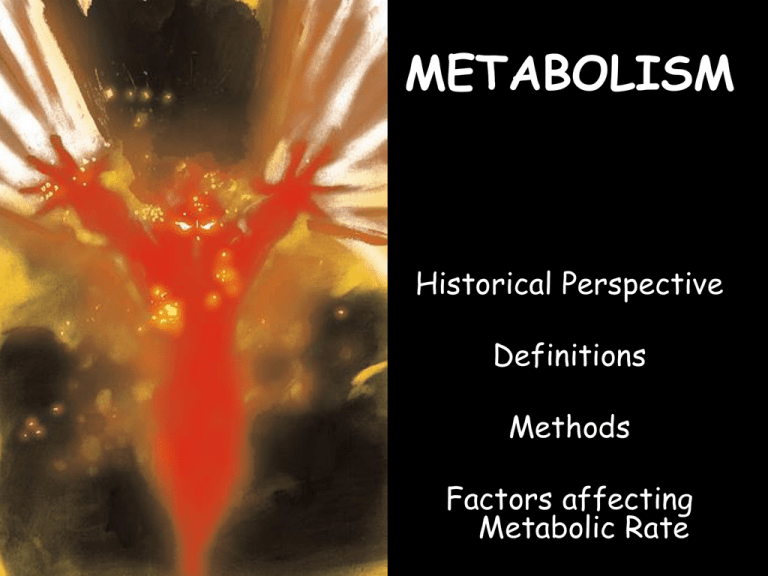
METABOLISM Historical Perspective Definitions Methods Factors affecting Metabolic Rate Antoine Lavoisier, 1773 • heat produced by an animal is proportional to O2 consumed and CO2 produced • so…“animal heat” is a byproduct of chemical reactions (metabolism) Energy Maintenance, growth, reproduction, activity Food/fuel is oxidized to form ATP Metabolism = sum of all biological transformations of energy and matter Metabolic Rate = Total energy metabolized by an organism per unit time Energy Maintenance, growth, reproduction, activity Food/fuel is oxidized to form ATP Aerobic metabolism: Fuel + O2 CO2 + H2O + ATP + heat Metabolic rate (MR, or E) = energy metabolism/time What does MR tell us? 1. Overall rate of all physiological activities 2. Resource needs 3. Rate of production of new tissue How can we measure MR? Aerobic metabolism: Fuel + O2 CO2 + H2O + ATP + heat Indirect measures Direct measures * 1. Direct measure of heat production = “direct calorimetry” Lavoisier & Laplace 79.9 cal melts 1 g ice (335 Joules) How can we measure MR? Aerobic metabolism: Fuel + O2 CO2 + H2O + ATP + heat Indirect measures Direct measures * 2. Indirect measure of MR food intake (fuel) O2 consumption CO2 production X metabolic water Complete oxidation of 1 mol glucose: Fuel + 6O2 (C6H12O6) 6CO2 + 6H2O + 2820 kJ •Amount of energy ingested, O2 consumed, or CO2 produced is directly related to amount of heat produced Measuring O2 consumption: Closed system respirometry: Volume = 1 L 1000 mls Initial O2 = 21% 210 mls O2 Final O2 = 15% (1 hour) 150 mls O2 E = 0.06 L O2 /hr Measuring O2 consumption: Open system respirometry (flow through): Constantly measure O2 consumption Respirometry: Open and Closed Can be used to measure BOTH: Oxygen consumption Carbon Dioxide Production 2. Indirect measure of MR food intake (fuel) O2 consumption CO2 production X metabolic water Complete oxidation of 1 mol glucose: Fuel + 6O2 (C6H12O6) 6CO2 + 6H2O + 2820 kJ •Amount of energy ingested, O2 consumed, or CO2 produced is directly related to amount of heat produced •BUT, heat production varies with foodstuff being oxidized… BUT, heat production varies with foodstuff being oxidized… HEAT PRODUCTION (KJ) Per gram of food Per liter of O2 consumed Per liter of CO2 produced carbohydrates 17.1 21.1 21.1 lipids 38.9 19.8 27.9 Proteins (urea) 17.6 18.7 23.3 Relatively constant, but not exact… E = 0.06 L O2 /hr Heat produced per liter of O2 consumed (KJ/L) carbohydrates To convert to heat production: 1) Use appropriate conversion factor (on left) - possible if you know food source 21.1 lipids 19.8 Proteins (urea) 18.7 -OR- 2) Use a “representative” conversion factor - 20.2 KJ/L Thre is a more complicated method, but you need to measure both O2 consumption and CO2 production (rare) How does energy use compare between lab and field? Values of MR in field are 3X higher than in lab!! Why? Field metabolic rate, (“FMR”) accounts for activity levels! How can we measure FMR? Doubly labeled water: dual isotope technique can use with free-ranging terrestrial animals no equipment attached to animal measures CO2 production O H 18O H (Water) H 3H (Doubly-labeled water) Doubly-labeled water 18O H 3H measure the “washout” rates of 3H and 18O Inject into animal • 3H lost as body water (urination, sweating, breathing…) **Loss rate for 18O • 18O is lost as water and CO2 is steeper than for 3H isotope in body Doubly-labeled water Initial sample 3H Final sample 18O time Convert to estimates of CO2 production… Doubly-labeled water inject a known quantity into animal let equilibrate, take blood sample release animal recapture, take 2nd blood sample isotope in body Initial sample 3H Final sample 18O time 3H : 18O Doubly-labeled water 18O H Is it accurate? • Predicts CO2 production w/in 3-8% Limitations? • cost of analysis • radioisotope use in field 3H What factors affect an animal’s metabolic rate? 1. Activity What factors affect an animal’s metabolic rate? 2. Digestion: “specific dynamic action” = MR increase after a meal Humans: 30% Why? •Amount •Type 1.4 kJ meal 5.6 kJ meal What factors affect an animal’s metabolic rate? 2. Digestion: “specific dynamic effect” = MR increase after a meal 3. Starvation Metabolic rate drops Why might this be adaptive? What factors affect an animal’s metabolic rate? 4. Reproductive Status • Humans: MR increases 30% near term -growth of fetus -fetal metabolic requirements -growth of mammary tissue • Golden-mantled ground squirrels: - lactation takes up 1/3 of yearly energy budget! What factors affect an animal’s metabolic rate? Many animals lower MR well below resting levels 5. Hibernation, Estivation,Torpor 6. Endothermy vs. Ectothermy Relatively high MR Relatively low MR 6. Endothermy vs. Ectothermy physiological correlates of huge MR difference 1. Higher SA/V in lungs; complex, efficient heart 2. Mitochondrial membrane SA ~4-5X bigger 3. Greater enzyme activity 6. Endothermy vs. Ectothermy What does measuring O2 consumption tell us? Endotherms: Ectotherms: basic metabolism basic metabolism thermoregulation digestion digestion activity activity reproduction/growth reproduction/growth “Basal MR” “Standard MR” 7. Temperature affects MR endotherms BMR ?? “tnz” MR Basal Metabolic Rate: Animal must be: -in TNZ -resting -fasting temperature Thermoneutral zone = range of temps within which MR is unaffected by temp change 7. Temperature affects MR ectotherms “Standard Metabolic Rate” Animal must be: -fasting -resting * SMR is specific to body temp SMR MR temperature 7. Temperature affects MR ectotherms endotherms “tnz” BMR SMR MR MR temperature temperature BMR: -in TNZ -resting -fasting SMR: -fasting -resting -temperature specific Metabolic Rate Summary • What is MR and how can you measure it? – – – – Direct Colorimetry (heat production) Food Consumption Oxygen Consumption Carbon Dioxide Production • Field metabolic rate • Factors affecting metabolic rate: – – – – – – – Activity Digestion Starvation Reproductive Status Hibernation, Estivation, Torpor Endothermy vs. Ectothermy Temperature METABOLISM Historical Perspective Definitions Methods Factors affecting Metabolic Rate BUT, heat production varies with foodstuff being oxidized… HEAT PRODUCTION (KJ) Per gram of food Per liter of O2 consumed Per liter of CO2 produced RQ carbohydrates 17.1 21.1 21.1 1.0 lipids 38.9 19.8 27.9 0.7 Proteins (urea) 17.6 18.7 23.3 0.8 What if you aren’t sure what animal ate? “Respiratory Quotient” = Rate of CO2 production Rate of O2 production
